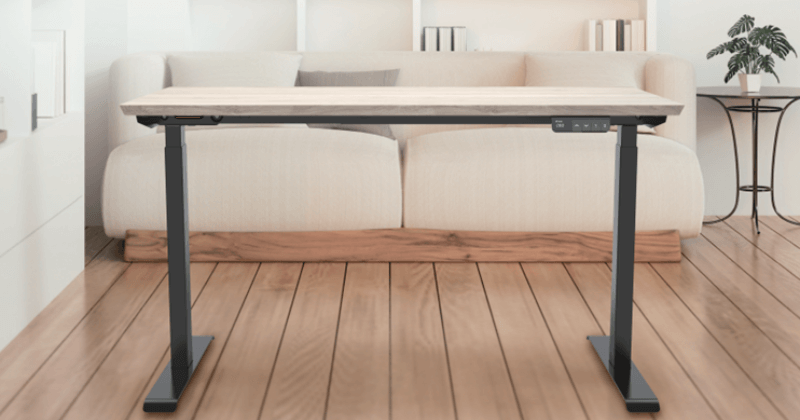2017/09/06
Health Benefits of Sit-Stand Desks
Noticias/Artículos
In recent years, height-adjustable desks, also known as standing desks or sit-stand desks, have seen a surge in popularity, both in workplaces and home offices. This increasing trend can be attributed to growing awareness about the adverse health effects of prolonged sitting. Studies have shown that sitting for extended periods is associated with a higher risk of health problems like cardiovascular diseases, obesity, and musculoskeletal issues.
Height-adjustable desks provide an innovative solution to this problem. These desks allow users to alternate between sitting and standing throughout the day, providing a more dynamic work experience. Integrating sit-stand desks into daily routines aims to address health concerns and improve productivity and well-being. In this article, we will explore the health benefits of using height-adjustable desks, discuss their advantages for both companies and employees and provide tips on how to make the most of this ergonomic solution.

What is a Height-Adjustable Desk?
A height-adjustable desk, also known as a sit-stand desk, is a type of desk that allows users to switch between sitting and standing positions throughout their workday. These desks are designed to provide a flexible workspace that can be easily adjusted to meet the user's preferred height, either by using electric motors, manual cranks, or gas lift mechanisms.
Height-adjustable desks come in various forms, including electric desks with button control panels, gas-lift desks with pneumatic adjustments, and manual desks operated by a lever. Additionally, desk converters can be placed on traditional desks to offer sit-stand functionality. These desks aim to help users alternate postures throughout the day, reducing health risks linked to prolonged sitting and promoting better ergonomics.
Switching between sitting and standing helps reduce strain on muscles and joints, especially in the lower back, neck, and shoulders. This dynamic approach to working helps maintain healthy circulation, improves posture, and ultimately contributes to better overall health. Sit-stand desks are increasingly being adopted in offices and home environments, especially as more people work remotely.

Benefits of Height-Adjustable Desks to Companies
Height-adjustable desks are not just beneficial for individual users; they also offer significant advantages to companies. Below are some of the key benefits for businesses that invest in height-adjustable desks:
- Increased Productivity: Studies have found that employees who use standing desks often experience improved productivity. Alternating between sitting and standing can help employees stay more focused, alert, and engaged throughout the day, which ultimately benefits the company.
- Reduced Absenteeism: Height-adjustable desks can help improve the health and well-being of employees, leading to fewer instances of absenteeism. By reducing the health risks associated with prolonged sitting, such as back pain and musculoskeletal problems, companies can minimize sick days and enhance overall workforce efficiency.
- Boosted Employee Morale: Providing height-adjustable desks demonstrates that a company values its employees’ health and well-being. This simple investment can lead to higher job satisfaction and morale, making employees feel more appreciated and motivated.
- Enhanced Ergonomics: Poor ergonomics can lead to workplace injuries and discomfort, affecting productivity. Height-adjustable desks help reduce these risks by allowing employees to customize their workspace to suit their body dimensions, reducing the chances of injury and fatigue.
- Cost Savings: Over time, investing in height-adjustable desks can lead to reduced healthcare costs for companies. By improving employee health and preventing common workplace-related injuries, companies can save money on healthcare premiums and compensation claims.
.png)
Benefits of Height-Adjustable Desks for Employees
Height-adjustable desks offer numerous health and wellness benefits to employees. Below are some of the key advantages:
- Reduced Back and Neck Pain: Prolonged sitting can lead to chronic back and neck pain. Height-adjustable desks allow employees to alternate positions, alleviating pressure on the spine and reducing discomfort.
- Improved Posture: Switching between sitting and standing encourages better posture, as it helps maintain the natural curvature of the spine. Standing desks reduce the likelihood of slouching, which is common during extended periods of sitting.
- Better Circulation: Sitting for long hours restricts circulation and can cause swelling in the legs and feet. Using a height-adjustable desk helps employees move more frequently, improving blood flow and reducing the risk of circulation problems.
- Weight Management: Alternating between sitting and standing can help employees burn more calories compared to sitting alone. Even slight increases in daily movement can contribute to better weight management and reduce the risk of obesity.
- Increased Energy Levels: Standing throughout the day can help employees feel more energized and less fatigued. By incorporating standing sessions, employees can avoid the sluggishness often associated with prolonged sitting.
- Reduced Risk of Chronic Diseases: Prolonged sitting has been linked to an increased risk of conditions like type 2 diabetes, cardiovascular disease, and certain cancers. Height-adjustable desks can mitigate these risks by encouraging more movement throughout the day.
(1).png)
Tips for Maximizing the Benefits of a Standing Desk
To get the most out of a height-adjustable desk, it is important to use it correctly. Here are some practical tips for both companies and employees:
- Alternate Between Sitting and Standing: The key benefit of a height-adjustable desk lies in the ability to change positions. Aim to alternate between sitting and standing every 30 to 60 minutes to avoid muscle fatigue and maintain circulation.
- Adjust the Desk Height Correctly: Ensure the desk is adjusted to the proper height to maintain an ergonomic posture. When standing, the desk should be at elbow height, with the screen at eye level to prevent neck strain.
- Use an Anti-Fatigue Mat: Standing for prolonged periods can be tiring. An anti-fatigue mat provides cushioning for the feet and helps reduce the pressure on joints, making standing more comfortable.
- Wear Supportive Footwear: Comfortable, supportive shoes are essential when using a standing desk. Wearing the right footwear can prevent foot pain and make the transition between sitting and standing more comfortable.
- Move Around Regularly: While standing desks are great, they are not a replacement for regular movement. Be sure to take short walks throughout the day to stretch muscles, promote circulation, and give your body a break.
- Personalize the Workspace: To make the most of a standing desk, personalize it with accessories like monitor arms, keyboard trays, or cable management tools. These additions can help maintain an organized and ergonomic workspace.
Conclusion
The health benefits of standing desks are numerous. Sit-stand desks provide an effective solution to today's sedentary lifestyle challenges. By following best practices for using height-adjustable desks, you should notice significant improvements in your health, productivity, and overall mood over time. Start gradually with your sit-stand desk and increase your standing time progressively. This approach helps your body adjust to being more active, promoting a healthier and less sedentary lifestyle.
TiMOTION offers a comprehensive range of height-adjustable desk frame series, blending innovative design with user-friendly features. Contact us and discover how TiMOTION can help you create an ergonomic and productive workspace today!
Frequently Asked Questions (FAQ)
Q1: How long should I stand at a height-adjustable desk each day?
A: It's recommended to alternate between sitting and standing every 30 to 60 minutes. Standing for too long can cause fatigue, so frequent changes in posture are key.
Q2: Are height-adjustable desks difficult to set up?
A: No, most height-adjustable desks are easy to set up and come with clear instructions. Electric height-adjustable desks are especially user-friendly with simple control panels.
Q3: Are height-adjustable desks suitable for home offices?
A: Absolutely. Height-adjustable desks are ideal for home offices, providing flexibility, improving posture, and helping create a healthier work environment for remote workers.


















